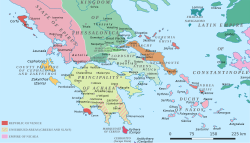This article needs additional citations for verification. (February 2019) |
Principality of Achaea | |||||||||
|---|---|---|---|---|---|---|---|---|---|
| 1205–1432/1454 | |||||||||
Coat of arms of the Villehardouin Princes of Achaea
(first ruling dynasty)Coat of arms of the Zaccaria family (last ruling dynasty) | |||||||||
 The Principality of Achaea and the other Greek and Latin states of southern Greece, c. 1210 | |||||||||
| Status | Client state* | ||||||||
| Capital | Andravida (1205–1249) Mystras (1249–1261) Aetos (1453–1454) | ||||||||
| Common languages | French officially, Greek popularly | ||||||||
| Religion | Roman Catholic, Greek Orthodox popularly | ||||||||
| Government | Feudal monarchy | ||||||||
| Prince of Achaea | |||||||||
• 1205–1209 | William I | ||||||||
• 1404–1432 | Centurione II | ||||||||
• 1453–1454 | Centurione III | ||||||||
| Historical era | Middle Ages | ||||||||
| 1204 | |||||||||
| 1205 | |||||||||
| 1259 | |||||||||
• Angevin takeover | 1278 | ||||||||
• Achieved full sovereignty | 1404 | ||||||||
• Absorbed in Despotate of the Morea | 1432 | ||||||||
• Revival of the last dynasty | 1453 | ||||||||
• Exile of the last ruling prince | 1454 | ||||||||
• Disestablished | 1432/1454 | ||||||||
| |||||||||
| Today part of | Greece | ||||||||
* The principality was a client state of, in order, the Kingdom of Thessalonica, then the Latin Emperors at Constantinople, the Angevins of the Kingdom of Naples, until the purchase of 1404 by Centurione II Zaccaria. | |||||||||
The Principality of Achaea (/əˈkiːə/) or Principality of Morea was one of the vassal states of the Latin Empire, which replaced the Byzantine Empire after the capture of Constantinople during the Fourth Crusade.[1] It became a vassal of the Kingdom of Thessalonica, along with the Duchy of Athens, until Thessalonica was captured by Epirus in 1224. After this, Achaea became the dominant power in Greece, lasting continuously for 227 years and cumulatively for 229.

